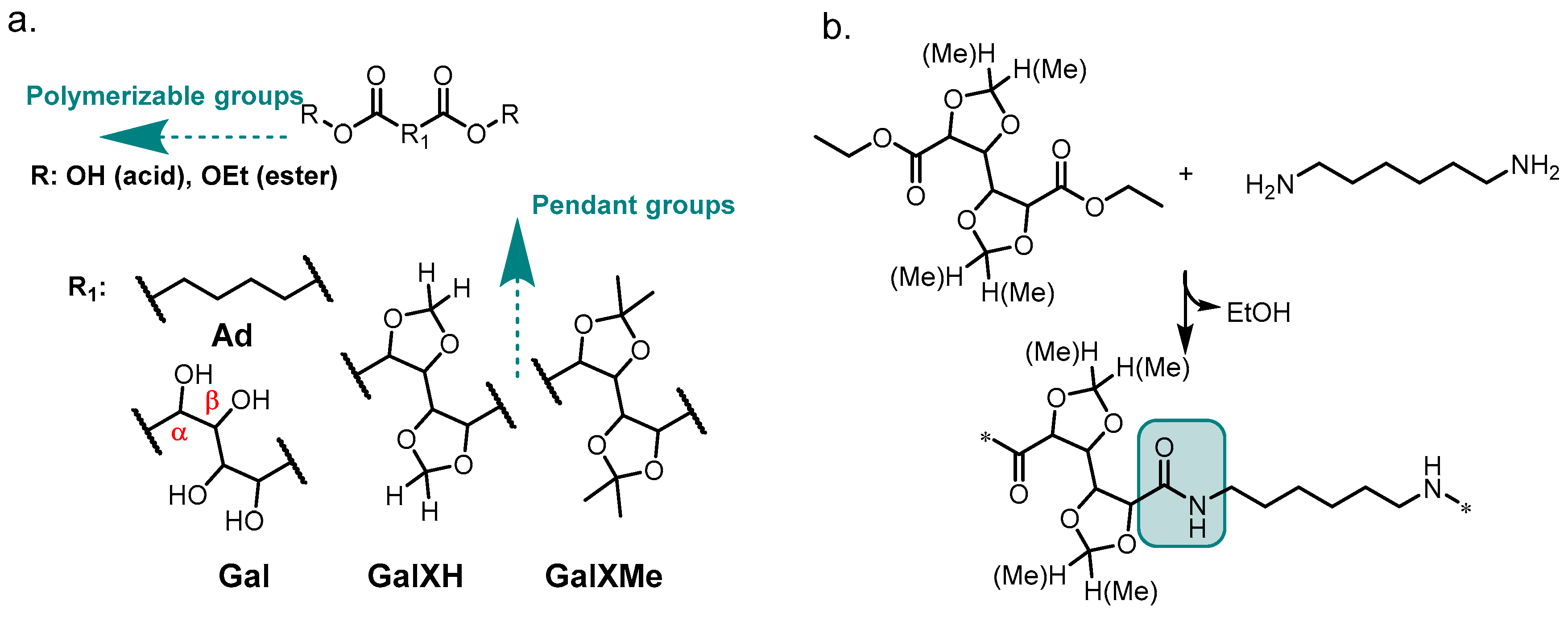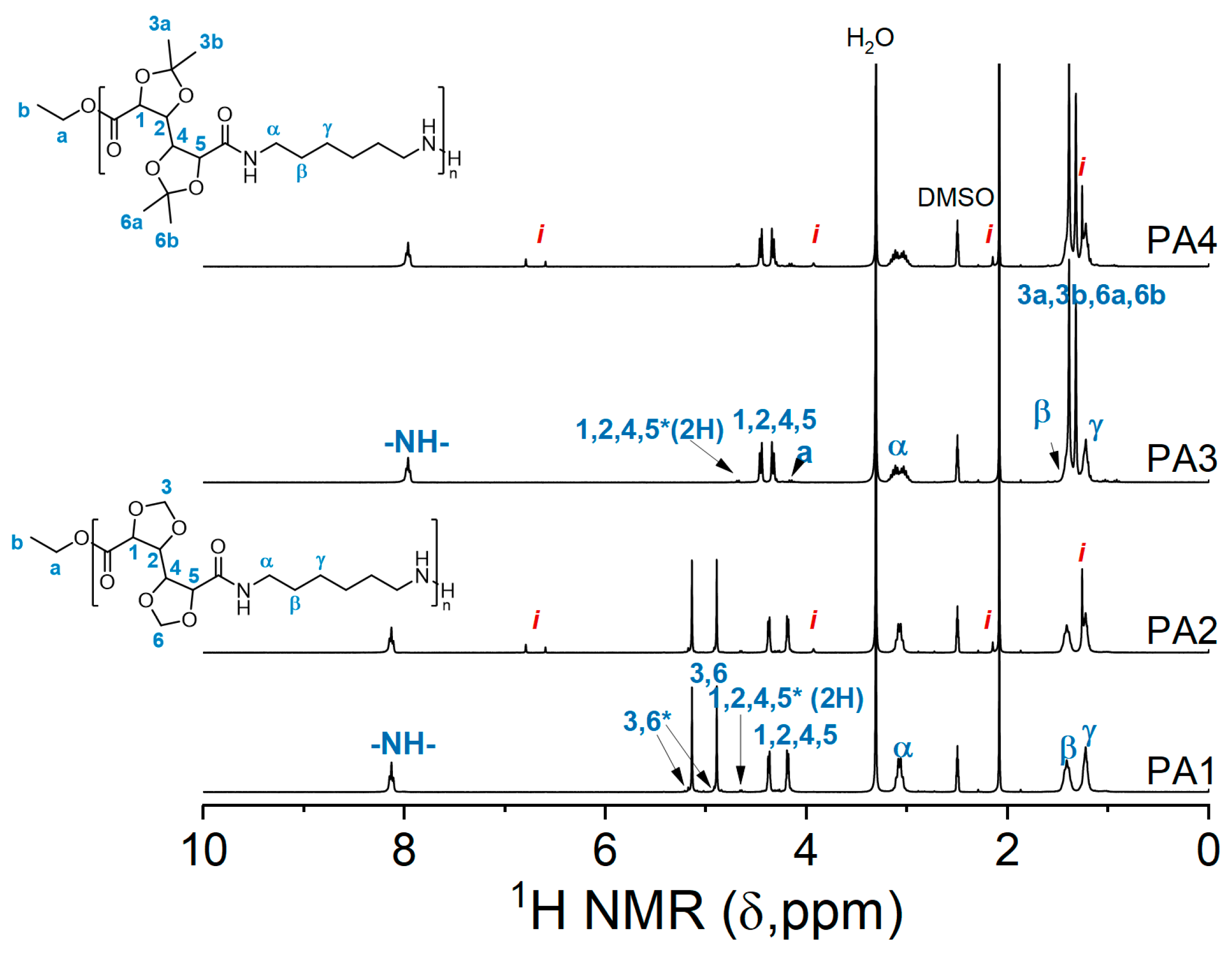Radical Formation in Sugar-Derived Acetals under Solvent-Free Conditions
Abstract
:1. Introduction
2. Results and Discussion
2.1. Radical Degradation Study of the Acetal Fragments
2.2. Polymerization
3. Experimental Section
3.1. Materials and Methods
3.1.1. Materials
3.1.2. Methods
3.1.3. Synthesis of Polymers
4. Conclusions
Author Contributions
Funding
Institutional Review Board Statement
Informed Consent Statement
Data Availability Statement
Acknowledgments
Conflicts of Interest
Sample Availability
References
- Greene, T.W.; Wuts, P.G.M. Greene’s Protective Groups in Organic Synthesis; John Wiley & Sons, Inc.: Hoboken, NJ, USA, 2007. [Google Scholar]
- Capps, D.B. Linear polycyclospiroacetals and method for preparing them. U.S. Patent Application No. 2889290, 1 October 1956. [Google Scholar]
- Munoz-Guerra, S. Carbohydrate-based polyamides and polyesters: An overview illustrated with two selected examples. High Perform. Polym. 2012, 24, 9–23. [Google Scholar] [CrossRef] [Green Version]
- Wroblewska, A.; Wildeman, S.M.A.; Bernaerts, K.V. the consequences of the incorporation of (aliphatic/cycloaliphatic) sugar-based non-drop-in monomers into polyamides: In-depth study on representative examples. In Recent Advances in Polyamides Research; Correia, N.G., Ed.; NOVA: New York, NY, USA, 2019. [Google Scholar]
- Wróblewska, A.A.; Bernaerts, K.V.; De Wildeman, S.M.A. Rigid, bio-based polyamides from galactaric acid derivatives with elevated glass transition temperatures and their characterization. Polymer 2017, 124, 252–262. [Google Scholar] [CrossRef]
- Wroblewska, A.; Stevens, S.; Garsten, W.; Wildeman, S.M.A.; Bernaerts, K.V. A solvent-free method for the copolymerization of labile sugar-derived building blocks into polyamides. ACS Sustain. Chem. Eng. 2018, 6, 13504–13517. [Google Scholar] [CrossRef] [PubMed]
- Picchioni, F.; Gavrila, I. Synthesis and Use of Carbohydrate-Based Linear Polyesters. WO Patent 2018/186744 Al, 11 October 2017. [Google Scholar]
- Wróblewska, A.A.; De Wildeman, S.M.A.; Bernaerts, K.V. In-depth study of the synthesis of polyamides in the melt using biacetal derivatives of galactaric acid. Polym. Degrad. Stab. 2018, 151, 114–125. [Google Scholar] [CrossRef]
- Ogata, N.; Sanui, K.; Hosoda, K.; Nakamura, H. Active polycondensation of diethyl 2,3,4,5-tetra hydroxy adipate with diamines. J. Polym. Sci. Polym. Chem. Ed. 1976, 14, 783–792. [Google Scholar] [CrossRef]
- Ogata, N.; Sanui, K.; Hosoda, K.; Nakamura, H. Copolycondensation of hydroxyl diesters and active diesters with hexamethylenediamine. J. Polym. Sci. Polym. Chem. Ed. 1977, 15, 1523–1526. [Google Scholar] [CrossRef]
- Ogata, N.; Sanui, K.; Ohtake, T.; Nakamura, H. Solution polycondensation of diesters and diamines. Polym. J. 1979, 11, 827–833. [Google Scholar] [CrossRef] [Green Version]
- Rodriquez-Galan, A.; Bou, J.J.; Munoz-Guerra, S. Stereoregular polyamides derived from methylene-l-tartaric acid and aliphatic diamines. J. Polym. Sci. A Polym. Chem. 1992, 30, 713–721. [Google Scholar] [CrossRef]
- Anastas, P.T.; Warner, J.C. Green Chemistry: Theory and Practice; Oxford University Press: New York, NY, USA, 1998. [Google Scholar]
- Wróblewska, A.A.; Noordijk, J.; Das, N.; Gerards, C.; De Wildeman, S.M.A.; Bernaerts, K.V. Structure—Property relations in new cyclic galactaric acid derived monomers and polymers therefrom: Possibilities and challenges. Macromol. Rapid Commun. 2018, 34, 1800077. [Google Scholar] [CrossRef] [PubMed]
- Ogata, N.; Sanui, K.; Nakamura, H.; Kishi, H. Polycondensation of diethyl mucate with hexamethylenediamine in presence of poly(vinyl pyridine). J. Polym. Sci. Polym. Chem. Ed. 1980, 18, 933–938. [Google Scholar] [CrossRef]
- Gavrila, I.; Raffa, P.; Picchioni, F. acetalised galactarate polyesters: Interplay between chemical structure and polymerisation kinetics. Polymers 2018, 10, 248. [Google Scholar] [CrossRef] [PubMed] [Green Version]
- Buettner, G.R. Spin Trapping: ESR parameters of spin adducts. Free. Radic. Biol. Med. 1987, 3, 259–303. [Google Scholar] [CrossRef]
- Goodrow, M.H.; Villarreal, J.A.; Grubbs, E.J. Kinetic study of the thermal decomposition of (Z)-N-tert-butyl-.alpha.-phenylnitrone. J. Org. Chem. 1974, 39, 3447–3449. [Google Scholar] [CrossRef]
- Fielding, A.J.; Franchi, P.; Roberts, B.P.; Smits, T.M. EPR and computational studies of the formation and β-scission of cyclic and acyclic dialkoxyalkyl radicals. J. Chem. Soc. Perkin Trans. 2 2002, 155–163. [Google Scholar] [CrossRef]
- Rosu, C.; Negulescu, I.I.; Cueto, R.; Laine, R.; Daly, W.H. Synthesis and characterization of complex mixtures consisting of cyclic and linear polyamides from ethylbis-ketal galactarates. J. Macromol. Sci. Part A Pure Appl. Chem. 2013, 50, 940–952. [Google Scholar] [CrossRef]
- Rogers, M.E.; Long, T.E. Synthetic Methods in Step-Growth Polymers; John Wiley & Sons, Inc.: Hoboken, NJ, USA, 2003. [Google Scholar]
- Kéki, S.; Zsuga, M.; Kuki, Á. theoretical size distribution in linear step-growth polymerization for a small number of reacting species. J. Phys. Chem. B 2013, 117, 4151–4155. [Google Scholar] [CrossRef] [PubMed]
- Stoll, S.; Schweiger, A. EasySpin, a comprehensive software package for spectral simulation and analysis in EPR. J. Magn. Reson. 2006, 178, 42–55. [Google Scholar] [CrossRef] [PubMed]




| Polymer | ||||||||
|---|---|---|---|---|---|---|---|---|
| Diethyl Acetal Type | Diamine Type | Inhibitor b (wt%) | Polymer Code | GPC c | NMR d | |||
| Mn (kg·mol−1) | Ð | Mn,NMR (g·mol−1) | DP (−) | pGalX (%) | ||||
| GalXH | HMDA a | 0 | PA1 | 23.7 | 4.53 | 8300 | 26 | 96.3 |
| GalXH | HMDA a | 5 | PA2 | 16.3 | 2.93 | 6900 | 22 | 95.6 |
| GalXMe | HMDA a | 0 | PA3 | 15.0 | 1.83 | 8200 | 22 | 95.7 |
| GalXMe | HMDA a | 5 | PA4 | 14.0 | 1.88 | 7000 | 19 | 95.0 |
Publisher’s Note: MDPI stays neutral with regard to jurisdictional claims in published maps and institutional affiliations. |
© 2021 by the authors. Licensee MDPI, Basel, Switzerland. This article is an open access article distributed under the terms and conditions of the Creative Commons Attribution (CC BY) license (https://creativecommons.org/licenses/by/4.0/).
Share and Cite
Wróblewska, A.A.; Ching, H.Y.V.; Noordijk, J.; De Wildeman, S.M.A.; Bernaerts, K.V. Radical Formation in Sugar-Derived Acetals under Solvent-Free Conditions. Molecules 2021, 26, 5897. https://doi.org/10.3390/molecules26195897
Wróblewska AA, Ching HYV, Noordijk J, De Wildeman SMA, Bernaerts KV. Radical Formation in Sugar-Derived Acetals under Solvent-Free Conditions. Molecules. 2021; 26(19):5897. https://doi.org/10.3390/molecules26195897
Chicago/Turabian StyleWróblewska, Aleksandra A., H. Y. Vincent Ching, Jurrie Noordijk, Stefaan M. A. De Wildeman, and Katrien V. Bernaerts. 2021. "Radical Formation in Sugar-Derived Acetals under Solvent-Free Conditions" Molecules 26, no. 19: 5897. https://doi.org/10.3390/molecules26195897
APA StyleWróblewska, A. A., Ching, H. Y. V., Noordijk, J., De Wildeman, S. M. A., & Bernaerts, K. V. (2021). Radical Formation in Sugar-Derived Acetals under Solvent-Free Conditions. Molecules, 26(19), 5897. https://doi.org/10.3390/molecules26195897







